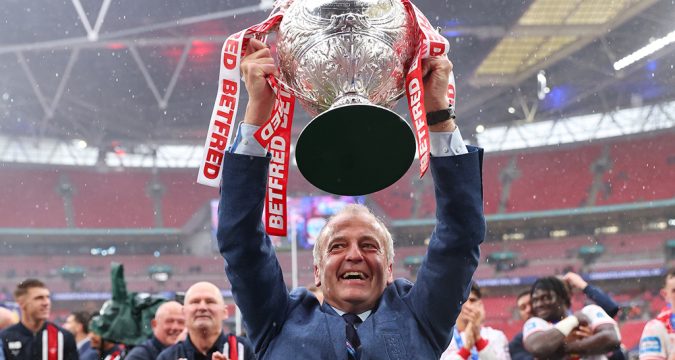
IT’S a general truism in football or Rugby League that the worst place to lose a game is Wembley Stadium.
And if you wanted the proof of that theory, you only had to look at the Warrington players after Saturday’s game.
You would have needed a heart of stone not to feel sorry for them and, for that matter, for their supporters.
They had been at least the equal of Hull KR throughout the game and, as we got into the final five minutes, it looked as though they were going to hold on for a 6-2 victory.
The massed ranks of Hull KR supporters – somewhat in excess of 15,000 of them – had gone quiet, clearly expecting the misery of defeat to be theirs.
But then we had a remarkable passage of play that turned the game upside down.
There have been many spectacular tries in the history of Challenge Cup Finals.
But the try scored by Tom Davies certainly wasn’t one of them.
But rarely has there been a more important try for altering the outcome of a game.
Is it possible to imagine a more dramatic ending to a Challenge Cup Final?
That late try, when it was converted by the ice-cool Mikey Lewis, created elation and misery in equal measure.
Scored right in front of the Hull KR supporters, it literally changed their lives, as well as the lives of the Robins’ players and coaching staff.
Without it, their agonising wait for a major trophy would have continued. And the Robins fans would have returned to Hull feeling devastated.
Instead that was the fate of the Warrington supporters, who don’t need reminding that this is just the latest of a series of defeats in major finals in the last ten years, punctuated by their Challenge Cup Final defeat of St Helens in 2019.
I genuinely believe that the victory has taken an enormous weight off the shoulders of everyone at the Hull KR club.
They can now go to bed at night knowing that they have won a major trophy and they are capable of doing it again.
And when you look at the last 30 years of the club’s history, you begin to recognise the scale of its achievement.
In the 1994/5 season it was in the then National League 1 and its average home crowd was just over 1,900.
In 1997 the club was in such major trouble that it almost went out of existence. We might almost say that it was the Salford of those days, given the Red Devils’ current plight.
Its fortunes began to turn around when Neil Hudgell came to the rescue and bought the club in 2004.
But the club was still in League One, with an average crowd in that year of 2,186.
Nonetheless, under Hudgell’s guidance the club’s rise really began and in 2006 they hosted Widnes Vikings at Craven Park in the National League Grand Final with a place in Super League at stake.
They attracted a crowd of 13,024 to that game on 8th October that year and they were clearly seen then as a rising club.
Relegation in 2016 after an extraordinary Million Pound Game against Salford didn’t halt their momentum, largely because Hudgell stuck with the club, although he came close to selling it in 2020 in the Covid era but stepped back from doing so.
Since then they have gone from strength to strength and the appointment of Willie Peters as their head coach in late 2022 was possibly the most crucial decision the club made.
Peters initially transformed the club from being one that made up the numbers to being a contender, and now he’s made the club a trophy winner.
I just hope that the club can hang on to him for many more years.
The other achievement of those who run the club has been to make it such a vital part of the community in east Hull. The Robins represent their community at least as well as any other sporting club.
And there’s one other point that needs making about the event on Saturday.
Anyone who suggests that the Challenge Cup Final should be moved from Wembley should immediately be sent to have their head examined.
Even though we seem unable to fill in these days, there is no other sporting experience for Rugby League fans that is the equivalent of going to Wembley.
Let’s focus on persuading more people of that fact, rather than talking about the Challenge Cup upping sticks and moving elsewhere.
The game apparently attracted more than a million viewers on BBC1 and I would very much like to know what the consensus of opinion was about the game from those viewers who were not regular Rugby League supporters.
To those of us in the stadium, it was an extraordinarily tense game played, for the most part, in heavy rain and with both sets of supporters creating a great atmosphere.
The drama was tremendous.
